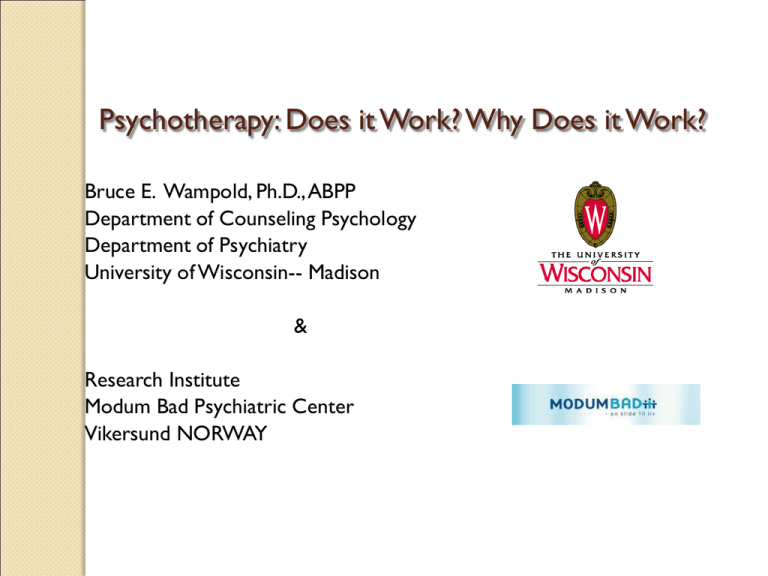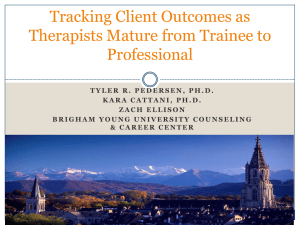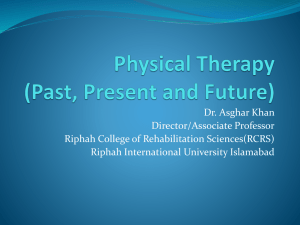
Psychotherapy: Does it Work? Why Does it Work?
Bruce E. Wampold, Ph.D., ABPP
Department of Counseling Psychology
Department of Psychiatry
University of Wisconsin-- Madison
&
Research Institute
Modum Bad Psychiatric Center
Vikersund NORWAY
Does it work?
Psychotherapy v. No-tx
Eysenck, science, and behaviorism
Evidence from RCTs:
◦ Smith and Glass (1977)
◦ Effect size:
◦ g = (mean Tx - mean Control)/SD
es = .80
Accounts for 13% of variance in outcomes
Average treated person does better than 80% of
untreated persons
Psychotherapy works
NNT = 3 – three patients need to be treated to obtain
one additional success
Aspirin as a prophylaxis for heart attacks (NNT = 129)
Superior to interventions in cardiology, geriatric
medicine, asthma, flu vaccine, cataract surgery
Comparable to psychopharmacology interventions
Enduring and safe
Effects in practice comparable to benchmarks created
by RCTs
Elite club: Medicine and psychotherapy
Effect sizes
d
r
% variance
nnt
Description
.2
.10
1.0%
9
small
.3
.15
2.2%
6
.4
.20
3.8%
5
.5
.25
5.9%
4
.6
.29
8.3%
4
.7
.33
10.9%
3
.8
.37
13.8%
3
Tx v. No Tx
Medium
Large
How does it work?
Treatment
Common factors
Interaction of specific and common
factors– the contextual model
Specific Treatment Effects
Psychological treatments = built on
characteristics found in a variety of treatments,
including “the therapeutic alliance, the induction
of positive expectancy of change, and
remoralization,” but contain important “specific
psychological procedures targeted at the
psychopathology at hand” (Barlow, 2004, p. 873).
Empirically Supported Treatments
◦ Evidence based treatments
◦ 2 trials, > control or = EST, manual, 2 different
groups
Inference: Specified treatment differences will
exist
Treatment Differences
Treatment intended to be therapeutic
◦ Psychological rationale, trained therapists who
have allegiance to tx, no proscription of usual
therapeutic actions
Null Hypothesis:
◦ All treatment intended to be therapeutic are
equally effective
Wampold et al. (1997)
All direct comparisons across disorders
Effects homogeneously distributed about
zero– No evidence to reject the null
hypothesis
Upper bound
◦
◦
◦
◦
d = .2
% variance < 1%
NNT = 9
SMALL
Effect sizes
d
r
% variance
nnt
Description
.2
.10
1.0%
9
small
.3
.15
2.2%
6
.4
.20
3.8%
5
.5
.25
5.9%
4
.6
.29
8.3%
4
.7
.33
10.9%
3
.8
.37
13.8%
3
Tx A v. Tx B
Medium
Large
Depression
(see http://www.div12.org/PsychologicalTreatments
ESTs: behavioral activation, cognitive therapy,
interpersonal therapy, brief dynamic therapy,
reminiscence therapy, self-control therapy, social
problem solving therapy, self-system therapy,
acceptance and commitment therapy, behavioral
couple therapy, self/management self-control
therapy… and
The case of process-experiential therapy
Behavioral/cognitive behavioral not superior to
verbal therapies intended to be therapeutic
Dynamic therapies produce effect sizes
comparable to CBT
Does CBT work through specific ingredients?
CT for Depression (Jacobson et al.
1996)
The purpose of this study was to “provide an experimental test of
the theory of change put forth by A. T. Beck, A. J. Rush, B. F. Shaw,
and G. Emery (1979) to explain the efficacy of cognitive-behavioral
therapy (CT) for depression” (p. 295).
Complete Cognitive Therapy (CT)
◦ Behavioral activation (monitoring, activity assignment, social skills
training)
◦ Dysfunctional thoughts (Monitoring, assessment, reality testing,
alternative cognitions, examination of attributional biases,
homework)
◦ Core Schema (Identify core beliefs and alternatives, advantages
and disadvantages, modification of core beliefs)
Activation + modification of dysfunctional thoughts (AT)
Behavioral Activation (BA)
CT v. AT v. BA
Jacobson results
“According to the cognitive theory of depression, CT
should work significantly better than AT, which in turn,
should work significantly better than BA.”
BA = AT = CT
“These findings run contrary to hypotheses generated
by the cognitive model of depression put forth by Beck
and his associates (1979), who proposed that direct
efforts aimed at modifying negative schema are
necessary to maximize treatment outcome and prevent
relapse.”
Depression placebo responsive… “real disorders”
PTSD
PE, Stress Inoculation Training v.
Supportive Counseling (Foa et al.)
PE, SIT scientifically designed treatments
PE, SIT > Supportive Counseling
Conclusion:
◦ Exposure, cognitive change needed.
Supportive Counseling
“Patients were taught a general problem-solving
technique. Therapists played an indirect and
unconditionally supportive role. Homework
consisted of the patient’s keeping a diary of
daily problems and her attempts at problem
solving. Patients were immediately redirected to
focus on current daily problems if discussions of
the assault occurred.”
Belief of therapists delivering Supportive
Counseling?
But examine another study…
PTSD in Adult Female Childhood Sexual
Abuse (Completer Sample)
Measure
Tx A
Tx B
ES
% not ptsd
(3 month follow up)
47.1%
82.4%
35.0%
42.1
Clinician PTSD
38.5
47.2
.34
BDI
7.5
10.4
.31
Spielberger TAI
39.4
45.6
.53
TSI Beliefs
2.2
2.4
.39
Dissoc. experiences
7.6
9.4
.24
Cook Hostility
12.9
14.9
.27
Qual of Life
47.1
38.9
.58
PTSD in Adult Female Childhood
Sexual Abuse (Intent to treat)
Measure
% not ptsd
Tx A
27.6%
Tx B
31.8%
Effect size
Clinician PTSD
BDI
Spielberger TAI
53.1
12.9
46.2
47.2
10.8
46.4
-.22
-.18
.02
TSI Beliefs
Dissoc. experiences
Cook Hostility
2.7
12.4
21.6
2.4
11.5
17.1
-.41
-.09
-.54
Qual of Life
39.5
39.0
.03
PTSD Dropout Rate
Tx A
Tx B
Enrolled
29
22
Completed
17
20
Dropped out
12
2
% dropped
out
WL chose tx
41%
5/10 dropped
9%
0/9 dropped
PTSD
“As expected, our hypothesis that Tx A
would be more effective than WL
received consistent support. There was
no effect of either tx on quality of life.
Our hypothesis that Tx A would be
superior to Tx B received support (at
follow-up only). In summary, for women
who remained in Tx A, it was highly
effective.”
PTSD
Tx A = CBT, prolonged imaginal exposure, in vivo
exposure, cognitive restructuring, breathing retraining
◦ Psychologist therapist, Foa supervisor
◦ Cogent rationale
Tx B = PCT (Present-centered treatment)
◦ Rationale: impact of trauma on current functioning, systematic
approach to problem solving, manual.
◦ MSW therapists, trained by authors
◦ No cognitive or behavioral components (no exposure)
Quality of Life?
McDonagh et al. 2005
Present Centered Therapy
RCT 1: PCGT v TFGT
Scnurr et al. 2003
Vietnam Vets
PCGT
TFGT
No
Difference
Drop
CAPS Total
Rate***
severity
RCT 2: PCT v CBT
McDonagh et al. 2005
Childhood Sexual Abuse
PCGT
TFGT
No
Difference
Drop
CAPS
Rate *
RCT 3: PFGT v TFGT
Classen 2011
Childhood Sexual Abuse/HIV Risk
PCGT
TFGT
No Difference
Total
HIV
risk *
Anger/
Irratability**
PTSD Severity
CAPS B
BDI
CAPS C
PTSD
Checklist
General
Health Q
SF-36
Physical
SF Mental
STAI
DES
Sexual
revictimization
Substance Use
Risky Sex
COOK
# of partners
STAXI
Avoidance
QOLI
Reexperiencing
Interpersonal
Problems
Depression
Dissociation
Sexual
Concerns
Dysfunction
Sex
Impaired Selfreferences
Tension
Reduction
Posstraumatic
Growth
Drop Rate
Present Centered Therapy
3 Trials
Comparable (or better) than Evidencebased Treatment
> 2 Research groups
Manualized
Meets standards for evidence-based
treatment (Frost et al., submitted)
Consider EMDR
◦ Pseudo science, Mesmerism
Resick et al. 2008 PTSD
Cognitive Processing Therapy
Cognitive therapy only
Written Accounts
2hr/wk, 6 weeks (writing 45-60 min)
All 3 treatments showed improvement
Post Traumatic Diagnostic Scale
PTSD
Prolonged exposure, CBT, EMDR, hypnotherapy,
psychodynamic, trauma desensitization, presentcentered therapy, CBT without exposure
No differences among treatments intended to
be therapeutic (Benish, Imel, & Wampold, 2008)
Other diagnoses
◦ Panic: Panic Control Tx, Psychodynamic (Mildrod et
al., 2007)
◦ Alcohol Use Disorders
Meta-analysis of all tx, including CBT, MI, AA, etc.
No differences (Imel et al., 2008)
Children
Depression and Anxiety
◦ CBT = non-CBT (when intended to be
therapeutic) Spielmans, Pasek, & McFall, 2007
Depression, anxiety, conduct disorder,
ADHD
◦ Small differences
◦ Entirely explained by allegiance of researcher
Miller, Wampold, & Varhely, 2008
Meta-analysis of studies comparing
2 treatments
Meta-analysis of studies comparing
2 treatments
9 comparisons
Overall effect not significant
Only 1 of 9 statistically significant
◦ Markowitz: HIV Depressed men, IPT > CBT
NIMH funded 1992-2009
$11,760,874 (78,848,306 SEK)
Value?
If not treatment, then….
Common Factors
Alliance
Bond (i.e., relationship)
Agreement on Goals
Agreement on Tasks
Alliance and outcome correlation
Horvath et al. (2011) reviewed 190
studies, > 14,000 patients
Correlation of alliance at early session
and outcome
r = .27 d = .57 > MEDIUM
Effect sizes-- Alliance
d
r
% variance
nnt
Description
.2
.10
1.0%
9
small
.3
.15
2.2%
6
.4
.20
3.8%
5
.5
.25
5.9%
4
.6
.29
8.3%
4
.7
.33
10.9%
3
.8
.37
13.8%
3
Alliance
Medium
Large
Alliance and outcome correlation
Horvath et al. (2011) reviewed 190 studies,
> 14,000 patients
Correlation of alliance at early session and
outcome
r = .27 d = .57 > MEDIUM
Not confounded by improvement (Klein et al. 2003;
Crits-Christoph et al. 2011)
Other factors (Flückiger et al., 2012)
◦ CBT v non CBT
◦ Manual driven or not/Specific treatment
◦ Allegiance to alliance
Therapist or patient contribution?
Psychotherapy Relationships that
Work: Norcross
Relationships that Work (2011)
Factor
# Studies
# Patients
Effect size d
Alliance
190
> 14,000
.57
Alliance-Child & Adolescents
29
2630
.39
Alliance-Couple & Family
24
1461
.54
Empathy
59
3599
.63
Goal Consensus, Collaboration
15
1302
.72
Positive regard, affirmation
18
1067
.56
Congruence, genuineness
16
863
.49
Common Factors—Specific Factors
Factor
# Studies
# Patients
Effect size d
Alliance
190
> 14,000
.57
Alliance-Child & Adolescents
29
2630
.39
Alliance-Couple & Family
24
1461
.54
Empathy
59
3599
.63
Goal Consensus, Collaboration
15
1302
.72
Positive regard, affirmation
18
1067
.56
Congruence, genuineness
16
863
.49
Adherence to specific protocol
28
.04
Rated competence
18
.14
Webb, DeRubeis, & Barber, 2010
NOT SIGNIFICANT
Correlations v. RCTs
Correlation does imply causation
Issues with RCTs
◦
◦
◦
◦
◦
◦
Selection and Generalizability
Blinding
Distinguishability
Active ingredients
Therapist effects
Outcome measures
Therapist Effects
Definition: Some therapists consistently
attain better outcomes than other
therapists
Not due to contribution of patients
Not due to chance
Generalizable to the population of
therapists
Compare to effects for other factors (e.g.,
treatment differences)
Therapist Effects– The Evidence
Clinical Trials
◦ Selected, trained, supervised and monitored
◦ 8% of variability due to therapists
◦ Tx differences: At most 1 percent
Naturalistic settings
◦
◦
◦
◦
3% to 17% due to therapists
Across age, severity, & diagnosis
Possibly not across racial and ethnic groups
Cross validated
NIMH TDCRP reanalysis
Nested Design (CBT and IPT)
Well trained therapists, adherence monitored,
supervision
Elkin:
◦ The treatment conditions being compared in this study are, in
actuality, “packages” of particular therapeutic approaches and the
therapists who choose to and are chosen to administer them….
The central question… is whether the outcome findings for
each of the treatments, and especially for differences between
them, might be attributable to the particular therapists
participating in the study.
$6,000,000
(40,198,715.15 SEK)
Random Effects Modeling
Therapists considered a random factor
Therapists nested within treatments (multilevel model)
Final observations, controlling for pretest at patient and
therapist level
◦ Kim, Wampold, & Bolt, Psychotherapy Research, 2006
Random Effects Modeling
Therapists considered a random factor
Therapists nested within treatments (multilevel model)
Final observations, controlling for pretest at patient and
therapist level
Therapist slope fixed and random
◦ Kim, Wampold, & Bolt, Psychotherapy Research, 2006
Greater
Severity
Greater
Severity
Variance due to Tx: CBT v IPT
Variable
Treatment
BDI
0%
HRSD
0%
HSCL-90
0%
GAS
0%
Therapist
Variance due to Tx and Therapists
Variable
Treatment
Therapist
BDI
0%
5% - 12%
HRSD
0%
7% - 12%
HSCL-90
0%
4% - 10%
GAS
0%
8% - 10%
Note: Elkin et al. (2006) found negligible therapist
effects in the same data
Psychiatrist Effects–
Psychopharmacology
Antidepressants: Imipramine v. Placebo
30 minutes, biweekly
3% due to treatment
9% due to therapist
Best psychiatrists got better outcome
with placebo than worst psychiatrists
with imipramine
(McKay, Imel & Wamold, 2006)
Effect sizes– Therapists Effects
d
r
% variance
nnt
Description
.2
.10
1.0%
9
small
.3
.15
2.2%
6
.4
.20
3.8%
5
.5
.25
5.9%
4
.6
.29
8.3%
4
.7
.33
10.9%
3
.8
.37
13.8%
3
Therapists Effects
Medium
Large
Therapists make a difference
Characteristics and Actions of Effective
Therapists?
Consult Beutler (Handbook of
Psychotherapy and Behavior Change)
◦ We don’t know
◦ And we don’t care
◦ Education, agriculture, medicine…. And
psychotherapy
Fundamental unanswered question
Beginning to accumulate evidence
Btw: therapist effects inflates treatment
differences
Alliance: Patient v. Therapist
Contribution to Alliance
Counseling center consortium data
OQ pre and post, Alliance 4th session
331 patients, 80 therapists
Alliance/outcome correlation .24
3% of variance due to therapists
What is correlation of alliance with outcome
◦ Within therapists?
◦ Between therapists?
And the results….
Within or between?
Better
therapist
Therapist contribution to alliance is
critical
Patient contribution to alliance not
predictive of outcome
Therapist contribution is predictive of
outcome
Interaction not significant
Alliance is not a result of outcome
Interpersonal skills
Verbal fluency, interpersonal perception,
affective modulation and expressiveness,
warmth and acceptance, empathy, focus on
others
Measured with a challenge test
◦ Responses to vignettes
Accounts for therapist differences
◦ Anderson, Ogles, Patterson, Lambert, &
Vermeersch, D. A. (2009)
◦ Supported in meta-analyses (see Norcross,
Psychotherapy Relationships that Work)
Conclusions
Treatment
◦ Particular treatment not important
◦ Treatment IS important
Who delivers the treatment is primary
◦ Therapist who can form alliances with
patients
◦ Interpersonal skills
AN EVIDENCED-BASED
MODEL OF
PSYCHOTHERAPY
Relationship Elements
Real relationship, belongingness, social connection
Therapist
Trust,
Understanding,
Expertise
Better
Quality of
Life
Creation of expectation through explanation and
some form of treatment
Patient
Symptom
Reduction
Tasks/Goals
Therapeutic
Actions
Healthy
Actions
Initial formation of therapeutic bond
Humans evolved to
discriminate between
those who can be
trusted and those
who cannot
50 ms
Context, healing
practice
Nonverbal
Therapist
Trust,
Understanding,
Expertise
Patient
Real Relationship
Transference-free genuine relationship
based on realistic perceptions (Gelso, 2009)
Social relations = well being
Social isolation = pathology
Psychotherapy is uniquely ENDURING
Real relationship, belongingness, social connection
Trust,
Understanding,
Expertise
Better
Quality of
Life
Expectation
Expectation influence on well being
Placebo effects
Created in interpersonal interaction
Explanation of disorder
Agreement about tasks and goals of Tx
Treatment actions
Trust,
Understanding,
Expertise
Better
Quality of
Life
Creation of expectation through explanation and
some form of treatment
Symptom
Reduction
Specific Actions
Indirect Effect
Agreement tasks & goals adherence to
protocol
Healthy actions
Need to develop and test protocols
Better
Quality of
Life
Trust,
Understanding,
Expertise
Symptom
Reduction
Tasks/Goals
Therapeutic
Actions
Healthy
Actions
Conclusions
Relationship factors critical
◦ Real relationship
◦ Explanation expectations
◦ Agreement about tasks and goals healthy
actions
Human evolved to heal through social
means
Treatment important, but is the particular
treatment?
IMPROVE QUALITY OF CARE
Disseminate Evidence-based Treatments
Measure and manage outcomes
◦ Use best therapists
◦ Help poorer therapists improve
Provide therapists feedback
Provide training
◦ Common fctors
◦ Specific treatments
Thank You
Bruce E. Wampold, Ph.D., ABPP
Patricia L. Wolleat Professor of Counseling Psychology
Clinical Professor, Psychiatry
University of Wisconsin--Madison
Director, Research Institute
Modum Bad Psychiatric Center
Vikersund, Norway
bwampold@wisc.edu








